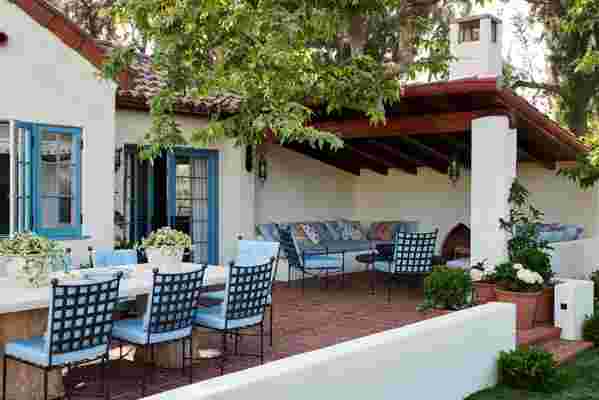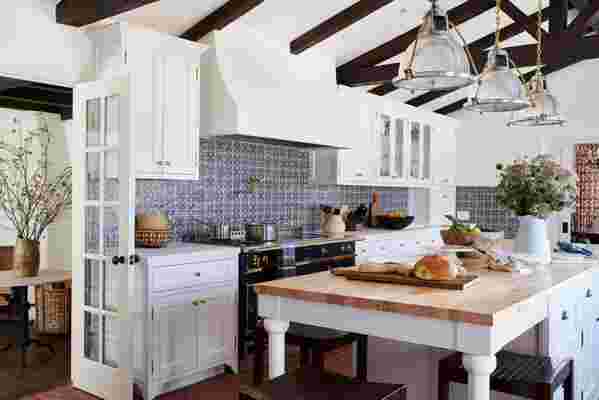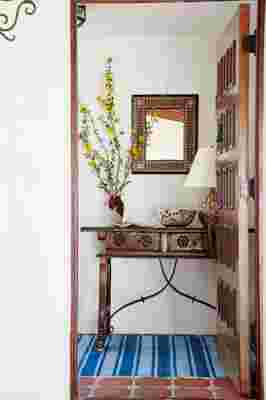What do an 1885 Victorian in San Francisco, an 1870s Federal townhouse in Manhattan, and an 1840 Greek Revival house in Sag Harbor have in common? They’re all the former pet projects of John de Neufville, a real estate investor whose passion for renovating historic homes stems from a lifelong love of architecture. “My mother grew up in New Orleans and always had an affection for old houses,” he says. The interest in them certainly rubbed off on him.
So when he heard about a historic 1924 Spanish Colonial home while contemplating a move with his family to Santa Monica—his wife, Allison de Neufville, a fashion consultant for brands like Dolce & Gabbana, Aerin Lauder, and Edie Parker, grew up on the West Coast—he knew he had landed on his next rehabilitation subject. “Despite its run-down condition, the house had this aura of greatness,” he remembers of their first visit. “We knew immediately that it was a project that we wanted to pursue.”

A Formations dining table and chairs from Janus et Cie set the stage for alfresco dinners on the back terrace. The custom banquette features fabric by Mariaflora ; the cocktail table is from Hollywood at Home ; and the lanterns are from ADG Lighting .
Of course, it wouldn’t be easy. Designed by celebrated Los Angeles architect John Byers for the actor Leo Carrillo, the house was well known to the Santa Monica Conservancy’s landmarks commission. What began as a call to architect Paul Brant Williger to update the house’s four fireplaces with sensitivity to Byers’s original design quickly ballooned into a full-scale historic preservation job that spanned three years. “We were all very dedicated to doing it right,” says Williger of the painstaking attention to the details involved in revitalizing the original plaster throughout the house, correcting previous structural work, reframing the kitchen ceiling, and repairing and replacing the existing flooring and windows. “John and Allison wanted to see a house that was restored to its former glory in a contemporary way and wasn’t willing to let modern conveniences compromise the aesthetics of the house. At the same time, it doesn’t feel like a museum. It retains the character of the house but feels fresh.”
Much of that has to do with the bold intervention of Los Angeles designer Mark D. Sikes, who pored over tomes about the California-Mediterranean aesthetic and researched the history of Spanish Colonial homes of the era, paying special attention to scale and authenticity. (The latter is a larger theme in his forthcoming book with Rizzoli called More Beautiful: All-American Decoration , available online and in bookstores on September 1.)

Colorful Mosaic House tiles play off traditional details like the Nanz Company hardware and Ann-Morris pendants and stools in the kitchen, which was gutted and reframed to create more generous proportions and an era-appropriate aesthetic.
“I wanted things to feel like they had been there for a while,” says Sikes of the eclectic assortment of Italian antiques, Portuguese ceramic tiles, and Moorish accents. “We made a conscious effort to salvage as much as we could, from the wrought-iron balusters on the staircase to some of the lighting.” Terra-cotta floors, dark wooden beams, and bronze lighting impart a sense of warmth throughout, while custom furnishings and de Neufville’s contemporary art collection give the California ease an unexpected edge. Flamboyant textiles play off each other in unexpected ways. “We couldn’t do a lot of treatments on the walls because of the plaster, so I really wanted to have fun with the fabrics.”
That sense of mirth is translated in the easygoing flow of the home. “The openness of the layout allows for a freedom of movement,” says de Neufville, noting that the design was conceived out of a need to build a house that the couple’s young son could grow into and feel at home in. “It’s not uncommon for him to run laps around the house because that’s how it’s designed.” The family-friendly property has become a backdrop for weeknight dinners and Saturday afternoon naps by the swimming pool, holiday gatherings and quiet mornings spent reading the newspaper. Though de Neufville’s obsession with beautiful homes remains strong as ever, the culmination of it all just might be enough to let him stay put for a while.
